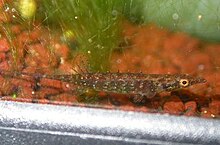Indostomidae
| Indostomus | |
|---|---|
 |
|
| I. paradoxus in an aquarium | |
| Scientific classification | |
| Kingdom: | Animalia |
| Phylum: | Chordata |
| Class: | Actinopterygii |
| Order: | Gasterosteiformes |
| Family: |
Indostomidae Prashad & Mukerji, 1929 |
| Genus: |
Indostomus Prashad & Mukerji, 1929 |
Indostomus is the sole genus of the monogeneric family Indostomidae, indigenous to freshwater habitats in Indochina. The indostomids are small, tropical fish in the stickleback order Gasterosteiformes, and are closely related to seahorses and pipefishes (family Syngnathidae).
The three currently recognized species in this genus are:
The first indostomid, I. paradoxus, was discovered in the 1920s in a lake in Burma. It was named the armoured stickleback, but is also called paradox fish and Burma stichling. The fish was morphologically unique, so the new family Indostomidae was erected for it. It is 3 to 4 cm in length and much smaller in width and height, similar to the pipefish. The body is extremely thin and cylindrical, especially caudally as it tapers to its thinnest point and ends in a fan-shaped tail fin. The body is thin and twiglike, covered in hard scutes, and bears five spines on its back and six on its operculum. It is a slow-moving, bottom-feeding fish that picks for food in the mud of swamps and rivers.
In the 1990s, two other species were discovered and placed into the genus Indostomus.I. crocodilus lives in Thailand and has habits similar to I. paradoxus. I. spinosus was found in the Mekong River, its tributaries, and adjoining swamps. In 2001, I. tiliosi was listed as a possible new species, but has not yet been officially described.
...
Wikipedia
